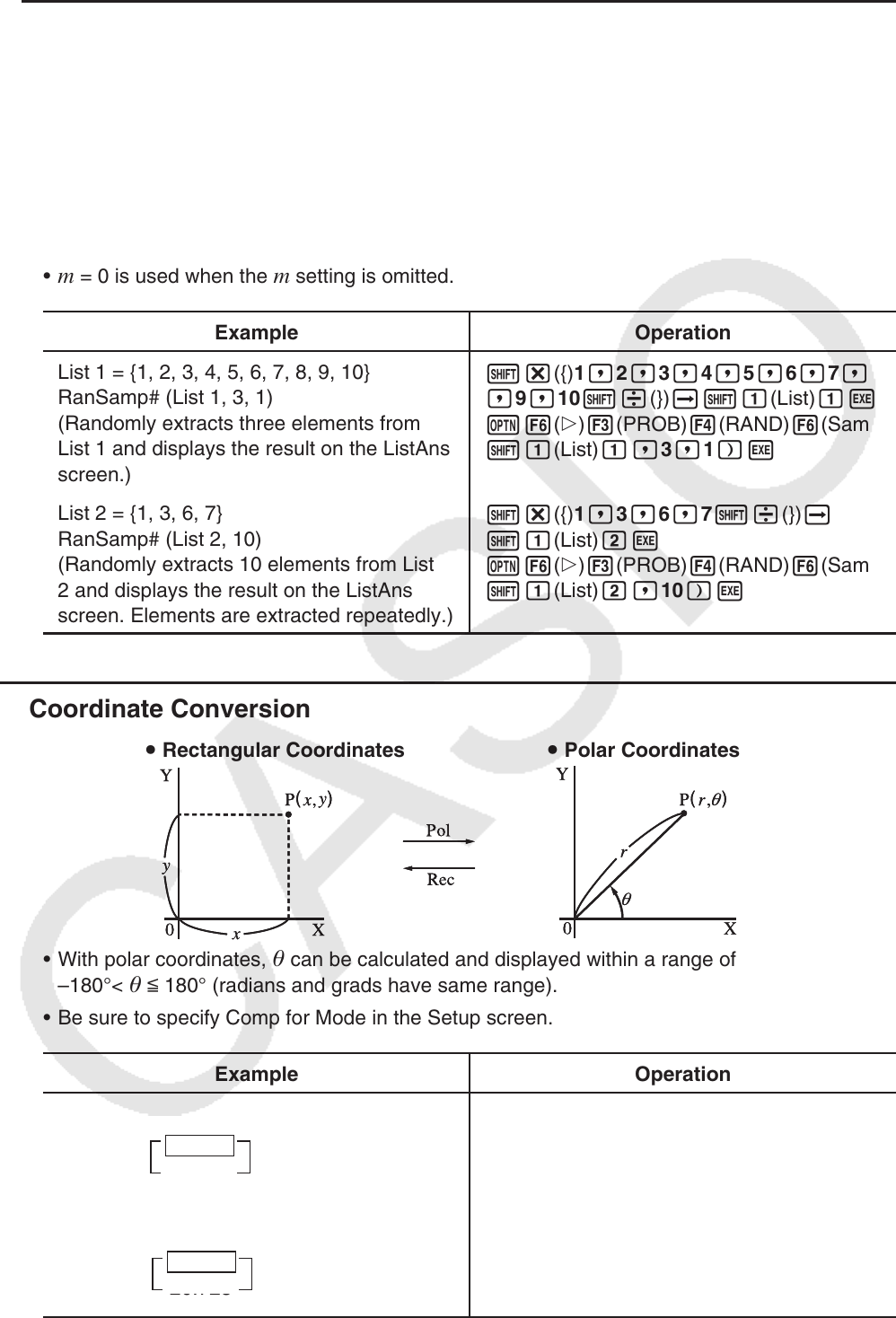User Manual
Table Of Contents
- Contents
- Getting Acquainted — Read This First!
- Chapter 1 Basic Operation
- Chapter 2 Manual Calculations
- 1. Basic Calculations
- 2. Special Functions
- 3. Specifying the Angle Unit and Display Format
- 4. Function Calculations
- 5. Numerical Calculations
- 6. Complex Number Calculations
- 7. Binary, Octal, Decimal, and Hexadecimal Calculations with Integers
- 8. Matrix Calculations
- 9. Vector Calculations
- 10. Metric Conversion Calculations
- Chapter 3 List Function
- Chapter 4 Equation Calculations
- Chapter 5 Graphing
- 1. Sample Graphs
- 2. Controlling What Appears on a Graph Screen
- 3. Drawing a Graph
- 4. Saving and Recalling Graph Screen Contents
- 5. Drawing Two Graphs on the Same Screen
- 6. Manual Graphing
- 7. Using Tables
- 8. Modifying a Graph
- 9. Dynamic Graphing
- 10. Graphing a Recursion Formula
- 11. Graphing a Conic Section
- 12. Drawing Dots, Lines, and Text on the Graph Screen (Sketch)
- 13. Function Analysis
- Chapter 6 Statistical Graphs and Calculations
- 1. Before Performing Statistical Calculations
- 2. Calculating and Graphing Single-Variable Statistical Data
- 3. Calculating and Graphing Paired-Variable Statistical Data (Curve Fitting)
- 4. Performing Statistical Calculations
- 5. Tests
- 6. Confidence Interval
- 7. Distribution
- 8. Input and Output Terms of Tests, Confidence Interval, and Distribution
- 9. Statistic Formula
- Chapter 7 Financial Calculation
- Chapter 8 Programming
- Chapter 9 Spreadsheet
- Chapter 10 eActivity
- Chapter 11 Memory Manager
- Chapter 12 System Manager
- Chapter 13 Data Communication
- Chapter 14 Geometry
- Chapter 15 Picture Plot
- Chapter 16 3D Graph Function
- Appendix
- Examination Mode
- E-CON4 Application (English)
- 1. E-CON4 Mode Overview
- 2. Sampling Screen
- 3. Auto Sensor Detection (CLAB Only)
- 4. Selecting a Sensor
- 5. Configuring the Sampling Setup
- 6. Performing Auto Sensor Calibration and Zero Adjustment
- 7. Using a Custom Probe
- 8. Using Setup Memory
- 9. Starting a Sampling Operation
- 10. Using Sample Data Memory
- 11. Using the Graph Analysis Tools to Graph Data
- 12. Graph Analysis Tool Graph Screen Operations
- 13. Calling E-CON4 Functions from an eActivity

2-21
u Random Extraction of List Data Elements (RanSamp#)
This function randomly extracts elements from list data and returns the results in list format.
RanSamp# (List X,
n [,m])
List X ... Any list data (List 1 to List 26, Ans, {list format data}, sub-name)
n ... Number of tries (When m = 1, the number of elements is 1 < n < List X. When m = 0,
1 <
n < 999.)
m ... m = 1 or 0 (When m = 1, each element is extracted only once. When m = 0, each
element can be extracted multiple times.)
•
m = 0 is used when the m setting is omitted.
Example Operation
List 1 = {1, 2, 3, 4, 5, 6, 7, 8, 9, 10}
RanSamp# (List 1, 3, 1)
(Randomly extracts three elements from
List 1 and displays the result on the ListAns
screen.)
!*({)1,2,3,4,5,6,7,8
,9,10!/(})a!b(List)bw
K6(g)3(PROB)4(RAND)6(Samp)
!b(List)b,3,1)w
List 2 = {1, 3, 6, 7}
RanSamp# (List 2, 10)
(Randomly extracts 10 elements from List
2 and displays the result on the ListAns
screen. Elements are extracted repeatedly.)
!*({)1,3,6,7!/(})a
!b(List)cw
K6(g)3(PROB)4(RAND)6(Samp)
!b(List)c,10)w
k Coordinate Conversion
u Rectangular Coordinates u Polar Coordinates
• With polar coordinates, can be calculated and displayed within a range of
–180°< < 180° (radians and grads have same range).
• Be sure to specify Comp for Mode in the Setup screen.
Example Operation
Calculate
r and ° when x = 14 and y = 20.7
!m(SET UP)cccccc
1(Deg)J
K6(g)5(ANGLE)6(g)1(Pol()
14,20.7)w
Calculate
x and y when r = 25 and = 56°
2(Rec() 25,56)w
1 24.989 → 24.98979792 (r)
2 55.928 → 55.92839019 ( )
θ
1 24.989 → 24.98979792 (r)
2 55.928 → 55.92839019 ( )
θ
1 13.979 → 13.97982259 (x)
2 20.725 → 20.72593931 (y)
1 13.979 → 13.97982259 (x)
2 20.725 → 20.72593931 (y)










